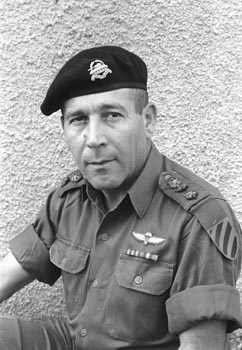 Israel Tal (Talik) was born in Zephath 1924. Tal began his military service with the British Army's Jewish Brigade, serving in Italy during the Second World War. In 1946 he joined the Haganah. In the War of Independence he commanded a platoon in the Givati Brigade. Following the war he served in command and instruction roles, reaching the role of training division head in the operations Directorate.
Israel Tal (Talik) was born in Zephath 1924. Tal began his military service with the British Army's Jewish Brigade, serving in Italy during the Second World War. In 1946 he joined the Haganah. In the War of Independence he commanded a platoon in the Givati Brigade. Following the war he served in command and instruction roles, reaching the role of training division head in the operations Directorate.
In 1954 he studied at the Senior Officers School in Britain. Tal served as an infantry brigade commander during the 1956 Sinai War. From December 1956 to April 1959 he served as deputy armored corps commander. Later he served as assistant head of the Operation Directorate of the General Staff, and Chief of Staff at the Northern Command.
In 1964 - 1969 Tal served as chief of the Armored Corps, where he developed the IDF's armored doctrine which has influenced armored doctrines in other parts of the world. He played a major role in the "War on Water" with Syria in the north of the country. In response to the construction of the National Water Conduit, and in order to disrupt the water supply in Israel, the Syrians shelled settlement in the Lake of Galilee area, and began diverting the Jordan River's sources. Talik retrained all Israeli gunners to hit targets beyond 1.5 kilometers, finally hitting Syrians tractors diverting the Jordan's estuaries, two, and even eleven kilometers away.
In the Six Day War Tal Commanded an armored division that fought in northern Sinai, occupying all territories from the Gaza Strip to the northern end of the Suez Canal. During the War of Attrition, in addition to his role as deputy Chief of Staff, Tal commanded the Southern Front. In 1970 – 1972 Tal established and headed the "Israeli Tank Administration," responsible for the development and production of the "Merkava" main battle tank. General Tal initiated the development and production of the tank at all its stages, including the notion that all of its components should protect its crew. The tank main innovative feature was the installation of its engine in front, thus adding to the crew's protection.
In 1972 Tal was appointed head of the Operations Branch in the General Staff, and in 1973 he became deputy Chief of Staff, a role in which served in the Yom Kippur war.
In 1974 Tal retired from the IDF and established the Institute for National Security Studies at the Tel-Aviv University.
Tal continued to be involved, actually carrying overall responsibility, to the development of the Merkava tank, and is considered the "Father of the Merkava" and "Mr. Armored Corps."
In October 1975 he was appointed assistant Minister of Defense in charge of armored vehicle development in the Ministry of Defense. In August 1977 he was specially appointed the examine the organization and functions of the IDF's land forces, and recommended the establishment of the Combat Corps Headquarters. In 1979 – 1989 he served again in the IDF, in addition to his role in the Ministry of Defense.
General Israel Tal died on September 8, 2010.
Tal was an educator, emphasizing dedication to the work and professionalism. While heading the Merkava project, he introduced new working methods and disciplines, including comparative experiments and the use of new technologies. He was a supporter of the "Telescopic Process," asserting that "Production will continue development."
Israel Tal was twice a recipient of the Israel Security Award - 1961, 1972 – for the development of the cylinder bridge. In 1997 he was awarded the Israel Prize for a special contribution to the State of Israel and its society. In 1996 he was picked out by the Patton Museum of Cavalry and Armor in Fort Knox (later renamed General George Patton Museum of Leadership), as one of the leading armor commanders in history.
His Book "National Security: The Israeli Experience" was published by Praeger Security International, in 2000.
Prepared with the assistance of Amira Shahar.